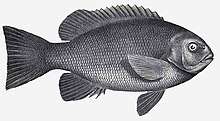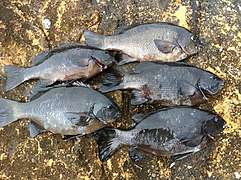Girella elevata
Girella elevata, the rock blackfish, Eastern rock blackfish, black rockfish or Eastern rock blackfish drummer is a species of marine ray-finned fish, a sea chub from the family Kyphosidae. It is found in the southwestern Pacific Ocean around eastern Australian and northern New Zealand.
| Girella elevata | |
|---|---|
 | |
| FMIB 36163 Girella elevata, Macleay | |
| Scientific classification | |
| Kingdom: | Animalia |
| Phylum: | Chordata |
| Class: | Actinopterygii |
| Order: | Perciformes |
| Family: | Kyphosidae |
| Genus: | Girella |
| Species: | G. elevata |
| Binomial name | |
| Girella elevata W. J. Macleay, 1881 | |

Description
Girella elevata has a moderately deep, compressed oval shaped body with a narrow caudal peduncle and a small head which has a slightly bulging forehead. It has a small mouth which does not extend as far as the eye and each jaw is equipped with a two rows of teeth, an outer row of flattened three-crowned teeth which do not overlap and an inner row of similar but much smaller teeth. It has ctenoid scales which cover much of the body and it has a continuous lateral line which is arched in parallel with the body's dorsal profile. The dorsal fin is continuous and there is almost no difference in form between the spiny and rayed parts of the dorsal fin. The spiny part is about a third longer tha the rayed portion. The spines become longer towards the trail and the soft rays are noticeably longer than the spines. The soft-rayed part of the dorsal fin is rounded. The anal fin is similar in shape to and lies opposite to the soft-rayed part of the dorsal fin. It has a very large and deeply forked caudal fin very large, broadly forked. It has small pectoral fins in which the upper rays are the longest and small pelvic fins, located below, and just to the rear of the base of the pectoral fins.[1] The dorsal fin has 14-16 spines and 11-12 soft rays while the anal fin has 3 spines and 11-12 soft rays. It can reach a length of 62 centimetres (24 in) standard length.[2] This species is uniformly blackish-brown to grey on their body[3] with a black margin along the posterior edge of the operculum. The juveniles are less uniformly coloured being more mottled as the dark colour is broken by bands on the back.[1] It can be confused with Silver Drummer (Kyphosus sydneyanus).[3]
Distribution
Girella elevata is found in the southwestern Pacific Ocean in coastal eastern Australia and northern New Zealand. In Australia it occurs from Noosa Heads, Queensland south to Apollo Bay in Victoria and northern Tasmania, although it is rare west of [[Wilsons Promontory] in Victoria. It is also found around Lord Howe Island in the Tasman Sea.[1]
Habitat and biology
Girella elevata show a preference as adults for areas of rocky reef in exposed situations where they can be found from the surf zone down to around 25 metres (82 ft). They are frequently observed by divers in caves or below ledges. The juveniles occur in rockpools, estuaries and areas of rocky reef in shallow waters.[4] This species may live as long as 45 years.[5] It is omnivorous and feeds on a range of invertebrates and algae.[3]
Fisheries
Girella elevata is a highly sought after target of recreational fishermen due to its reputation as a brutally tough fighter when hooked, said buy some to have given rise to the angler's colloquial name of pig, although it has also been suggested that stems from the sounds it makes when landed[4] and fine eating qualities.[6] Because its preferred habitat is in the white-wash around rocky outcrops immediately along the coastal shoreline, most anglers targeting rock blackfish are land-based. Rock blackfish can also be caught from water craft, but this is considered a high-risk activity due to the dangers of fishing very close to shore.[7]
Species description
Girella elevata was first formally described by William John Macleay in 1881 with the type locality being given as Port Jackson New South Wales.[8]
References
- Bray, D.J. (2018). "Girella elevata". Fishes of Australia. Museums Victoria. Retrieved 23 April 2020.
- Froese, Rainer and Pauly, Daniel, eds. (2019). &speciesname=elevata"Girella elevata" in FishBase. December 2019 version.
- "Rock blackfish Girella elevata". NSW Department of Primary Industries. Retrieved 22 April 2020.
- Mark McGrouther (14 January 2019). "Rock Blackfish, Girella elevata (Macleay 1881)". Australian Museum. Retrieved 23 April 2020.
- Stocks, Jerom R. (1 March 2015). Ecology of the eastern rock blackfish Girella elevata across a latitudinal gradient (PhD). University of New South Wales. p. 7.
- "Dealing with Drummer". Fishing World. October 2013. Retrieved 4 September 2018.
- Robley, James (August 2014). "Black drummer — A cymbal of success!". Queensland Fishing Monthly. Retrieved 4 September 2018.
- Eschmeyer, W. N.; R. Fricke & R. van der Laan (eds.). "Girella elevata". Catalog of Fishes. California Academy of Sciences. Retrieved 23 April 2020.